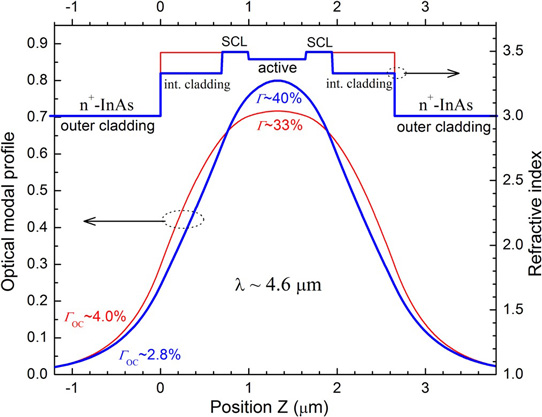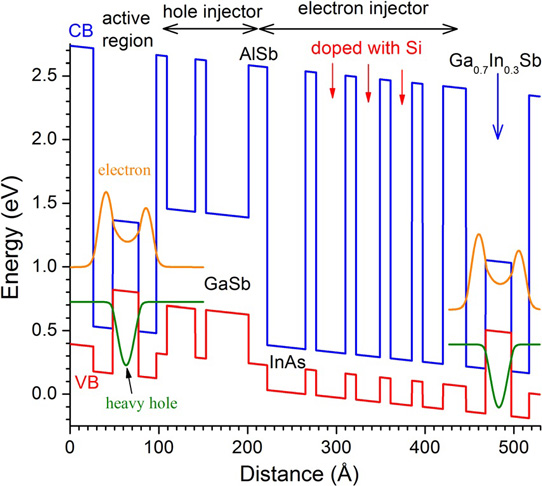- News
14 July 2015
Mid-infrared interband cascade lasers on indium arsenide substrate
University of Oklahoma in the USA has developed interband cascade (IC) lasers on indium arsenide (InAs) substrates with low threshold and high-current operation [Lu Li et al, Appl. Phys. Lett., vol106, p251102, 2015]. The researchers claim the threshold current of 247A/cm2 at 300K for a 4.6μm wavelength device as "the lowest ever reported among semiconductor mid-infrared lasers at similar wavelengths".
Interband cascade lasers on gallium antimonide (GaSb) substrates have achieved good results in the 3-4μm wavelength range. Devices developed on InAs substrates have longer wavelength up to 11μm. These devices use a heavily doped outer cladding layers to create a plasmon waveguide. However, such laser have only demonstrated pulsed operation up to now. The new Oklahoma work has also produced continuous-wave operation for the first time, according to the researchers.
The problem with plasmon waveguides with n+-InAs cladding is high optical absorption loss. Some groups have tried to overcome this by inserting thick (> 1μm) undoped InAs separate confinement layers at the cost of optical confinement, reduced optical gain, and increased current threshold.
To try to gain the best of both approaches, Oklahoma has inserted an intermediate cladding layer between the plasmon outer cladding and the separate confinement layers. The intermediate cladding pushes the optical field into the central part of the device and reduces the field in the outer plasmon cladding, avoiding absorption loss there (Figure 1).

Figure 1: Calculated optical modal profiles of interband cascade lasers without (thin lines) and with intermediate superlattice cladding layers (thick lines).
The laser diode heterostructures were grown on n-type InAs substrate using molecular beam epitaxy (MBE). The separate confinement and intermediate cladding layers were symmetrical about the active region based on multiple cascades (Figure 2).

Figure 2: Calculated band-edge diagram of one cascade stage and layer sequence.
The intermediate cladding consisted of a 25Å/23Å InAs/AlSb superlattice of which 3Å of the AlSb layer was an AlAs interface for strain balancing. Carrier transport was smoothed between the intermediate cladding and other parts of the device by transition/connection bridges consisting of digitally graded ~58nm InAs/AlSb(As) quantum wells.
Various broad-area mesa stripe and narrow-ridge laser diodes were produced with uncoated facets. The 1.5-2.0mm laser bars were mounted epi-side up on copper heat-sinks.
Broad-area (BA) devices with intermediate cladding in pulsed operation showed lower 300K threshold current density and higher-temperature operation, compared with a laser diode produced without intermediate cladding.
The researchers report that "a BA device from a 15-stage wafer [labeled] R140 had a threshold current density Jth of 247A/cm2 near 4.6μm at 300K, the lowest ever reported among mid-IR semiconductor lasers at similar wavelengths." They add: "Another BA device from a 10-stage wafer R144 lased at temperatures up to 377K near 5.1μm, . . . the highest operating temperature reported for electrically pumped interband lasers at this wavelength."
The characteristic temperature T0, representing the threshold shift, was in the range 46-57K for 10- and 12-stage BA laser diodes, which is comparable to state-of-the-art GaSb-based interband cascade lasers in the 3–4μm wavelength region, according to the team.
Continuous-wave performance was tested on narrow-ridge devices with a 4μm electro-plated gold top contact. The output wavelengths were in the range 4.6-4.9μm for 10- and 12-stage devices.
The 10-stage laser achieved higher-temperature performance since the operating voltage was lower. One 10-stage device managed 1.6mW/facet output power at 300K. The input power at threshold was less than 0.52W. Lower input power has been achieved in GaSb interband cascade lasers for shorter wavelengths of 3-4μm. The researchers say they are encouraged by the results from their initial attempt at implementing intermediate cladding in InAs substrate IC lasers.
The thermal resistance of the 10μm-wide ridge devices in continuous-wave operation was in the range 6.5-11K-cm2/kW. This is higher than for a reported device with thicker superlattice cladding (i.e. without intermediate cladding). "This suggests that there is still room for improving thermal dissipation of these InAs-based interband cascade lasers even without employing epilayer-down mounting," the team writes.
The narrow-ridge devices had similar high-temperature limits as the broad-area laser diodes in pulsed mode – up to around 376K. However, at temperatures below 320K, the current threshold was 45-71% higher. Shorter-wavelength 3-4μm interband cascade narrow-ridge laser thresholds are around 21% higher than for broad-area devices.
"This suggests a somewhat significant current leakage from the sidewalls due to imperfect passivation, which implies further room to achieve better performance by reducing this surface leakage," the team writes.
Substantial mode hopping was seen for the narrow-ridge devices at 310K, suggesting to the researchers that material non-uniformity was an issue.
Mid-infrared interband cascade lasers InAs substrates
http://dx.doi.org/10.1063/1.4922995
The author Mike Cooke is a freelance technology journalist who has worked in the semiconductor and advanced technology sectors since 1997.


